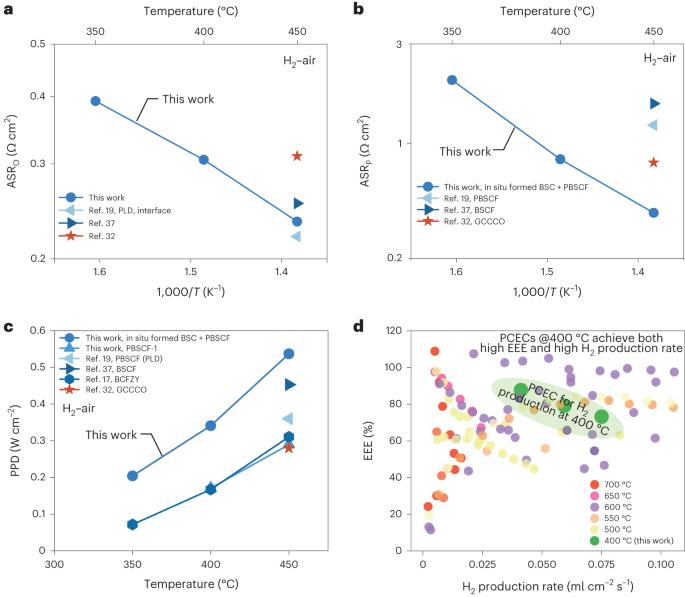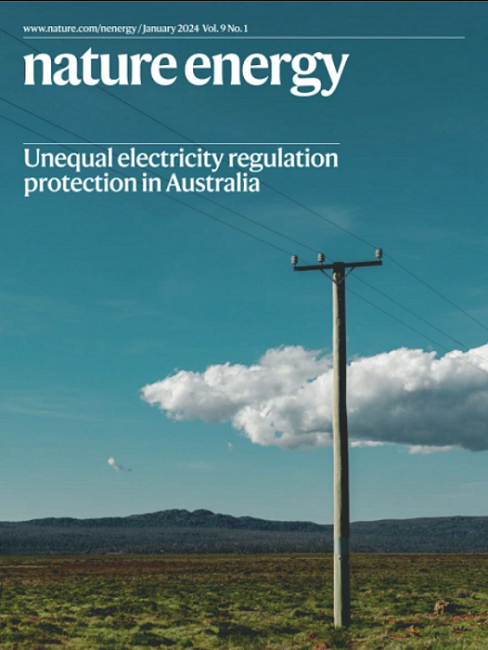将质子陶瓷电化学电池的工作温度降低到<450 °C
IF 60.1
1区 材料科学
Q1 ENERGY & FUELS
引用次数: 0
摘要
质子陶瓷电化学电池(PCEC)可用于发电和可持续制氢。降低 PCEC 的工作温度可促进其规模化和商业化。然而,在低工作温度下实现高能效和长期耐用性是一项长期挑战。在此,我们报告了一种制造超薄、化学均匀且坚固的质子传导电解质的简单且可扩展的方法,并展示了一种原位形成的复合正极--Ba0.62Sr0.38CoO3-δ-Pr1.44Ba0.11Sr0.45Co1.32Fe0.68O6-δ,它显著降低了欧姆电阻、正极-电解质接触电阻和电极极化电阻。PCEC 在燃料电池模式下可达到很高的功率密度(450 ℃ 时约为 0.75 W cm-2,275 ℃ 时约为 0.10 W cm-2),在蒸汽电解模式下可达到很高的电流密度(1.4 V 和 450 ℃ 时为 -1.28 A cm-2)。在 600 °C 时,PCEC 的功率密度达到 ~2 W cm-2。此外,我们还演示了在 450 °C 下直接利用甲烷和氨气发电。我们的 PCEC 在 400 °C 下也能稳定发电和制氢。陶瓷电化学电池通常在高温(≥500 °C)下工作,这对器件材料和结构造成了限制。在此,Liu 及其同事设计了可逆质子传导电化学电池,可在 450 °C 及以下的温度下高性能运行。本文章由计算机程序翻译,如有差异,请以英文原文为准。

Lowering the operating temperature of protonic ceramic electrochemical cells to <450 °C
Protonic ceramic electrochemical cells (PCECs) can be employed for power generation and sustainable hydrogen production. Lowering the PCEC operating temperature can facilitate its scale-up and commercialization. However, achieving high energy efficiency and long-term durability at low operating temperatures is a long-standing challenge. Here, we report a simple and scalable approach for fabricating ultrathin, chemically homogeneous, and robust proton-conducting electrolytes and demonstrate an in situ formed composite positive electrode, Ba0.62Sr0.38CoO3−δ–Pr1.44Ba0.11Sr0.45Co1.32Fe0.68O6−δ, which significantly reduces ohmic resistance, positive electrode–electrolyte contact resistance and electrode polarization resistance. The PCECs attain high power densities in fuel-cell mode (~0.75 W cm−2 at 450 °C and ~0.10 W cm−2 at 275 °C) and exceptional current densities in steam electrolysis mode (−1.28 A cm−2 at 1.4 V and 450 °C). At 600 °C, the PCECs achieve a power density of ~2 W cm−2. Additionally, we demonstrate the direct utilization of methane and ammonia for power generation at <450 °C. Our PCECs are also stable for power generation and hydrogen production at 400 °C. The typically high temperatures (≥500 °C) at which ceramic electrochemical cells operate place constraints on device materials and construction. Here Liu and colleagues design reversible proton-conducting electrochemical cells that can operate with high performance at temperatures of 450 °C and below.
求助全文
通过发布文献求助,成功后即可免费获取论文全文。
去求助
来源期刊

Nature Energy
Energy-Energy Engineering and Power Technology
CiteScore
75.10
自引率
1.10%
发文量
193
期刊介绍:
Nature Energy is a monthly, online-only journal committed to showcasing the most impactful research on energy, covering everything from its generation and distribution to the societal implications of energy technologies and policies.
With a focus on exploring all facets of the ongoing energy discourse, Nature Energy delves into topics such as energy generation, storage, distribution, management, and the societal impacts of energy technologies and policies. Emphasizing studies that push the boundaries of knowledge and contribute to the development of next-generation solutions, the journal serves as a platform for the exchange of ideas among stakeholders at the forefront of the energy sector.
Maintaining the hallmark standards of the Nature brand, Nature Energy boasts a dedicated team of professional editors, a rigorous peer-review process, meticulous copy-editing and production, rapid publication times, and editorial independence.
In addition to original research articles, Nature Energy also publishes a range of content types, including Comments, Perspectives, Reviews, News & Views, Features, and Correspondence, covering a diverse array of disciplines relevant to the field of energy.
 求助内容:
求助内容: 应助结果提醒方式:
应助结果提醒方式:


